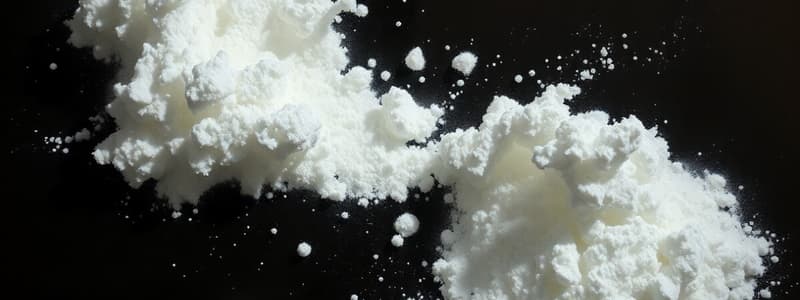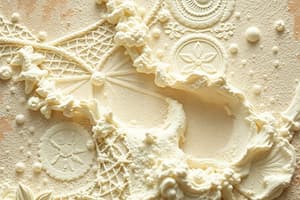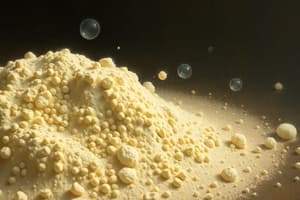Podcast
Questions and Answers
What best describes loosely packed powders?
What best describes loosely packed powders?
- They exhibit minimum airspace and maximum density.
- They lead to the highest porosity rates in packaging.
- They contain a maximum of airspace between particles. (correct)
- They have maximum interparticulate contact.
Which packing arrangement is associated with the lowest porosity?
Which packing arrangement is associated with the lowest porosity?
- Loosely packed powders
- Cubic packing
- Rhombohedral packing (correct)
- Tightly packed powders
What factor primarily influences the porosity of powders?
What factor primarily influences the porosity of powders?
- Liquid content in the mixture
- Temperature of the environment
- Weight of the powder
- Shape and size of the particles (correct)
What is the densest packing arrangement achieved by a mixture of particles?
What is the densest packing arrangement achieved by a mixture of particles?
How is porosity measured during the determination of powder packing?
How is porosity measured during the determination of powder packing?
What is the relationship between bulk volume and particle volume in terms of void volume?
What is the relationship between bulk volume and particle volume in terms of void volume?
How is porosity represented mathematically?
How is porosity represented mathematically?
What does the packing fraction (k) represent in relation to density?
What does the packing fraction (k) represent in relation to density?
What best describes the term 'apparent porosity'?
What best describes the term 'apparent porosity'?
In a tapped density measurement, what happens to the particles during tapping?
In a tapped density measurement, what happens to the particles during tapping?
What is the main purpose of a tap volumeter in powder characterization?
What is the main purpose of a tap volumeter in powder characterization?
Which statement is true regarding the lowest and highest bulk densities?
Which statement is true regarding the lowest and highest bulk densities?
Which condition affects the measurement of true density in powders?
Which condition affects the measurement of true density in powders?
What does a Carr's compressibility index of 12 indicate about powder flow?
What does a Carr's compressibility index of 12 indicate about powder flow?
Which Hausner ratio value indicates that added glidant may improve flow?
Which Hausner ratio value indicates that added glidant may improve flow?
In the context of powder properties, what is the significance of a larger difference between poured and tapped densities?
In the context of powder properties, what is the significance of a larger difference between poured and tapped densities?
What happens to a powder with a Hausner ratio greater than 1.5?
What happens to a powder with a Hausner ratio greater than 1.5?
A Carr’s compressibility index of 42 would classify the powder's flow as what?
A Carr’s compressibility index of 42 would classify the powder's flow as what?
What does a volume drop suggest about the most cohesive powders?
What does a volume drop suggest about the most cohesive powders?
Which factor primarily influences the difference between poured and tapped densities?
Which factor primarily influences the difference between poured and tapped densities?
If corn starch shows a 35% drop in volume on tapping, what does this suggest?
If corn starch shows a 35% drop in volume on tapping, what does this suggest?
Flashcards
Porosity of a powder
Porosity of a powder
A measure of the amount of air trapped between particles in a powder. It is influenced by particle size, shape, and packing arrangement.
Loosely packed powder
Loosely packed powder
A powder that is loosely packed with large spaces between particles, resulting in a high air content.
Tightly packed powder
Tightly packed powder
A powder that has minimum air trapped between particles, resulting in a dense and solid pack.
Powder expansion and contraction
Powder expansion and contraction
Signup and view all the flashcards
Densest packing arrangement
Densest packing arrangement
Signup and view all the flashcards
Poured Bulk Volume (Vb)
Poured Bulk Volume (Vb)
Signup and view all the flashcards
Poured Bulk Density (ρb)
Poured Bulk Density (ρb)
Signup and view all the flashcards
Void Volume (v)
Void Volume (v)
Signup and view all the flashcards
Porosity (ε)
Porosity (ε)
Signup and view all the flashcards
Particle Volume (Vp)
Particle Volume (Vp)
Signup and view all the flashcards
Tapped Volume (Vt)
Tapped Volume (Vt)
Signup and view all the flashcards
Tapped Density (ρt)
Tapped Density (ρt)
Signup and view all the flashcards
Dynamic Powder Packing
Dynamic Powder Packing
Signup and view all the flashcards
Carr's Compressibility Index
Carr's Compressibility Index
Signup and view all the flashcards
Hausner Ratio
Hausner Ratio
Signup and view all the flashcards
Tapped Density
Tapped Density
Signup and view all the flashcards
Bulk Density
Bulk Density
Signup and view all the flashcards
Interparticulate Forces
Interparticulate Forces
Signup and view all the flashcards
Glidant
Glidant
Signup and view all the flashcards
Cohesive Powder
Cohesive Powder
Signup and view all the flashcards
Enhance Flowability
Enhance Flowability
Signup and view all the flashcards
Study Notes
Preformulation - Bulk Powder Properties
- Powders exhibit various packing states, ranging from loosely packed (maximum airspace, minimum contact points) to tightly packed (minimum air entrapped, maximum interparticulate contact).
- Porosity is the relative amount of air entrapped between particles, affected by particle shape and size. Smaller particles fill voids between larger ones.
- A packing arrangement consisting of 75% coarse and 25% fine particles yields the densest arrangement.
- Porosity of isotropic shapes like cubes can vary. Cubical packing has approximately 48% porosity and rhombohedral packing has approximately 26% porosity.
- Cubic shapes with 55% porosity and 0% porosity are also considered.
- Coarse and fine particles influence packing density. Increasing the proportion of fine particles increases packing density.
- Determining porosity involves placing a powder in a measuring cylinder without disturbance (loose packing). This volume is the 'poured bulk volume'. Reciprocal of this is minimum bulk density. The void volume (difference between total volume and particle volume) is used to calculate porosity (ɛ). Porosity can also be expressed as a packing fraction (k).
- Tapped density is determined using a tapping volumeter. A rotating cam in the device creates a series of taps on the powder, leading to a minimal bulk volume, termed tapped volume (Vt). Reciprocal of this is 'maximum bulk density' or 'tapped density'. This method monitors dynamic powder packing with time.
- Packing and flow properties are closely associated. A larger difference between poured and tapped densities suggests that more tapping is needed to reach the tightest packing.
- Carr's compressibility index is used to assess flow properties. It is calculated as: ((Tapped density-bulk density)/Tapped density) x 100.
- Carr's Index ranges from 5-15 (Excellent flow), 12-16 (Good flow), 18-21 (Fair to passable flow), 23-35 (Poor flow), 33-38 (Very poor flow), >40 (Extremely poor flow).
- A glidant improves flow characteristics particularly in poor flow classifications.
- Hausner ratio is determined by tapping the powder and calculating (Tapping density/Poured density). Values less than 1.25 indicate good flow. Between 1.25 and 1.5, a glidant normally improves flow. Values greater than 1.5 indicate poor flow. Glidants do not necessarily improve flows well beyond ratio of 1.5.
- Table 1 provides characteristics of bulk powder. It includes measurements of median particle size, aspect ratio, volume, and Carr’s Index. Based on this data, lactose displays good flow properties while others like corn starch or MCC 50M have poor flow properties.
- Lactose's low volume drop and relatively larger particle size contribute to its good flow.
- Microcrystalline cellulose (MCC) exhibits a considerable drop in volume and low bulk density, limiting its suitability for certain applications (e.g., capsule filling).
- Angle of repose is the maximum angle between the surface of a pile of powder and a horizontal plane, indicating flow characteristics. Lower values suggest better flow.
- Hopper design impacts the flow from the hopper. Funnel flow involves some stationary powder, potentially causing rat-holing and segregation problems. Mass flow involves all powder in motion, promoting uniformity, and requiring specific manufacturing.
- Arch formation and rat-holing relate to hopper design; strong interparticle forces create arches in funnel flow.
- Inadequate emptying in funnel flow silos might result due to insufficient cone angles for bulk substance drainage.
- Mass flow enables the uniform movement of powder along the hopper walls.
- Critical orifice diameter is a powder characteristic related to arching/rat holing; it depends on particle size, flow, and the ratio between orifice and particle diameters (Do/Dp).
- Flow is improved with various measures including particle properties (size, shape, charge, moisture), equipment like hoppers, aeration, and force feeders and formulations like glidants.
Additional Notes
- Aeration and vacuum techniques enhance powder flow in hoppers and feeding devices.
Studying That Suits You
Use AI to generate personalized quizzes and flashcards to suit your learning preferences.




